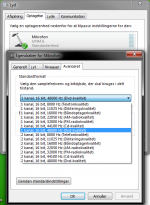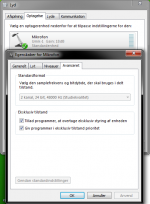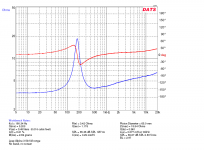Experience measurements microphones
Personally have one ECM8000 without calibration file one UMM-6 and one UMIK-1 both with manufacture calibration files, for me they all worked good and reliable so far. Would although add a note of the USB types than UMIK-1 seems faster than UMM-6 on transients and make nicer and more consistent impulse/step response plots verse EMM-6, probably this is because of electric hardware described below.
ECM8000 verse the USB ones have possibility into REW to math time of flight by ticking "Use loopback as timing reference" when one need to find acoustic offsets and so on.
EMM-6 electric hardware is a 16bit USB class 1 sound card device with various settings for sample rates see picture one below.
UMIK-1 electric hardware is a 24bit USB class 1 sound card device locked at 48kHz sample rate and can not be shifted (Greyed out) as seen picture two below.
Eldam,
Guess you located in France here some EU links.
UMIK-1 available at 99€ link here Lautsprecher Shop | blue planet acoustic.
UMM-1 available at 102,60€ link here https://www.intertechnik.com also they have other Daytons iMM6/eMM6/OmniMic v2.
Get your own ECM8000 a calibration file is available link here index also they have ECM8000 packages with freefield calibration file at 129€ and freefield/diffusefield calibration file at 146,85€ and is cost not the big problem they have their own brand EMX-7150 at 224,60€. If remember correct wesayso had his ECM8000 calibrated from their service and later bought one of their low noice mic preamps.
Personally have one ECM8000 without calibration file one UMM-6 and one UMIK-1 both with manufacture calibration files, for me they all worked good and reliable so far. Would although add a note of the USB types than UMIK-1 seems faster than UMM-6 on transients and make nicer and more consistent impulse/step response plots verse EMM-6, probably this is because of electric hardware described below.
ECM8000 verse the USB ones have possibility into REW to math time of flight by ticking "Use loopback as timing reference" when one need to find acoustic offsets and so on.
EMM-6 electric hardware is a 16bit USB class 1 sound card device with various settings for sample rates see picture one below.
UMIK-1 electric hardware is a 24bit USB class 1 sound card device locked at 48kHz sample rate and can not be shifted (Greyed out) as seen picture two below.
Eldam,
Guess you located in France here some EU links.
UMIK-1 available at 99€ link here Lautsprecher Shop | blue planet acoustic.
UMM-1 available at 102,60€ link here https://www.intertechnik.com also they have other Daytons iMM6/eMM6/OmniMic v2.
Get your own ECM8000 a calibration file is available link here index also they have ECM8000 packages with freefield calibration file at 129€ and freefield/diffusefield calibration file at 146,85€ and is cost not the big problem they have their own brand EMX-7150 at 224,60€. If remember correct wesayso had his ECM8000 calibrated from their service and later bought one of their low noice mic preamps.
Attachments
Last edited:
I have an Isemcon EMM-7101-CHTB. It is slightly thinner and shorter than a pencil, and it has an SMB connector at the back. It's only drawback is that it is so easy to loose due to its small size. I wanted to use the microphone for measuring frequency response (obviously), but I also wanted to be able to measure microphonics of components, and for that the small form factor is a nice bonus.
Thanks for that ! usefull links...
I tried in ARTA to calibrate myself at listening position the ECM8000 in a middle of a quiet night (15/20 dB noise floor, so very calm) to make a flat response in a file txt... but seems no to be a good method !
I read somewhere the only valid way to measure a driver or an enclosure is to dig it in the ground, the bafle must be at the same level than the ground and the mic seing towards the floor (so the speaker) !
Hey not easy for an OB ! But easier tha, a tower at 5 meter from the ground (or more). I read also the most closer things have not to be closer than 20 meters ! so Without big garden or a football stadium in the night, measurement are not so easy...
I find myself above 500/600 hZ a measurement in a living room at 3 meters, listening position is enough ! I don't listen in axial position or the speakers "toed in" !
I tried in ARTA to calibrate myself at listening position the ECM8000 in a middle of a quiet night (15/20 dB noise floor, so very calm) to make a flat response in a file txt... but seems no to be a good method !
I read somewhere the only valid way to measure a driver or an enclosure is to dig it in the ground, the bafle must be at the same level than the ground and the mic seing towards the floor (so the speaker) !
Hey not easy for an OB ! But easier tha, a tower at 5 meter from the ground (or more). I read also the most closer things have not to be closer than 20 meters ! so Without big garden or a football stadium in the night, measurement are not so easy...
I find myself above 500/600 hZ a measurement in a living room at 3 meters, listening position is enough ! I don't listen in axial position or the speakers "toed in" !
You can do what the multiway crowd has been doing for years with a semi-anechoic measurement at close range (circa 5cm for woofer) and moderate range (50cm) for tweeter and time gate (<5ms). Then "stitch" the LF and HF response together.
Look here at what Jeff Bagby wrote for the FRD response blender:
software
Look here at what Jeff Bagby wrote for the FRD response blender:
software
What app can be used with the mic to measure frequency response? I'd prefer an ipad app since I play music thru my ipad.
There are instructions for getting the app on PE website where you buy the iMM-6 mic:
Dayton Audio iMM-6 Calibrated Measurement Microphone for Tablets iPhone iPad and Android
It is called Studio 6 Digital - maybe search on iTunes app?
Get your own ECM8000 a calibration file is available link here index also they have ECM8000 packages with freefield calibration file at 129€ and freefield/diffusefield calibration file at 146,85€ and is cost not the big problem they have their own brand EMX-7150 at 224,60€. If remember correct wesayso had his ECM8000 calibrated from their service and later bought one of their low noice mic preamps.
Correct, I use the ECM800, I have one non calibrated and one I got from isemcon.net. Look at the example pdf: http://www.isemcon.net/ashop/datasheets/CAL-ECM8000-sample.pdf to get a feel for what the Behringer does by itself.
Usually they are pretty flat in a wide area but a non calibrated mic can only show you a difference or trend. The behringers show enough variation between them to get a calibrated one done by a shop you trust. If you see the following quote from Cross-Spectrum it will give you something to think about:
Cross-Spectrum said:Calibrated Behringer ECM8000 microphones
Effective immediately, Cross·Spectrum has ceased selling calibrated Behringer ECM8000 microphones. The quality of ECM8000 microphones has deteriorated to the point that we can no longer justify the effort in dealing with non-functioning units or mics with extremely abnormal frequency responses.
We will meet current orders and sell current stock at discounted prices. If you are looking for a calibrated microphone products, we suggest looking at one of the other products we sell:
•Calibrated miniDSP UMIK-1 USB microphones
•Calibrated Dayton Audio EMM-6 microphones
•Calibrated Dayton Audio UMM-6 USB microphones
•Calibrated Galaxy CM-140 sound level meters
A picture might help to show the variations in the Behringers:

With a calibrated mic you get the assurance of knowing what it is you're measuring.
I use the MPA-102 Microphone Preamp and am very satisfied with this combination. I still use a cheap RadioShack SPL meter to quickly calibrate SPL levels (while measuring with REW) and also to check my listening levels.
It's very easy to have my speakers play way to loud before you notice it really is that loud!
Last edited:
The dammar coated PS95 sounds pretty much the same. I went directly from the Vifa PC9 to the PS95. I believe the sibilance is partly attributable to the SMSL SA50 digital amp and the fact I am streaming from iTunes Radio. In comparison the tube amp I have has practically NO sibilance. Regardless, the PS95 sounds airier than the PC9. It reminds me of ADS speakers from the early 80's with their dome midrange and tweeter.
Essentially, on some music the sibilance remained. Overall, it had that same extra airy treble that characterizes the PS95. On good program material (Norah Jones or well recorded instrumental Jazz, for example) there was no sibilance - so the entire issue can be related to my source.
If all I ever do is coat an occasional driver the small bottle of dammar I purchased will last a lifetime.
Essentially, on some music the sibilance remained. Overall, it had that same extra airy treble that characterizes the PS95. On good program material (Norah Jones or well recorded instrumental Jazz, for example) there was no sibilance - so the entire issue can be related to my source.
If all I ever do is coat an occasional driver the small bottle of dammar I purchased will last a lifetime.
Is the Behringer better than the Dayton mike for readings? Can't decide between the two.
I have the behringer ECM8000 and X has the dayton umm6 and our measurements of the same drivers are reasonably close. behringer is a very good mic, but the umm6 has the advantage of custom calibration and easy usb connection. behringer has the advantage that it can be used for recording with any XLR input preamp.
Edit: sorry didn't read the whole discussion. I mean x's umik and behringer are close in distortion measurement. both are good. I have no problems with the ecm8000.
If I would get another measurement mic I would get an earthworks m23 or tc20
http://www.sweetwater.com/store/detail/TC20
http://www.earthworksaudio.com/microphones/m-series/m23/
I could use for measuring and omni mic recordings
Last edited:
actually all the earthworks mic are factory calibrated at the factory and the calibration is wired into each mic. there is a preamp and eq circuit in the body of every earthworks mic and each unit gets qc and a custom eq adjustment. they are expensive because of the high level of qc. but with the calibration hardwired into each mic there is no worry about external calibration files.
I also heard that maybe only 20% of their diaphragms pass their high level of qc and make it into microphones and the rest are thrown away.
but they are mostly sold for their excellent recording quality and for professional sound engineers.
I guess my point is that I am happy enough with my ecm8000 that it would take an earthworks mic to convince me to 'upgrade'.
I also heard that maybe only 20% of their diaphragms pass their high level of qc and make it into microphones and the rest are thrown away.
but they are mostly sold for their excellent recording quality and for professional sound engineers.
I guess my point is that I am happy enough with my ecm8000 that it would take an earthworks mic to convince me to 'upgrade'.
Last edited:
I also heard that maybe only 20% of their diaphragms pass their high level of qc and make it into microphones and the rest are thrown away.
.
I doubt they are thrown away, most probably sold to other mic producers. Naim have quite high out sorting of their expensive stuff, but the rejected components are sold to other producers……
Peter
 ..... round 5 now online: http://www.diyaudio.com/forums/full...d-comparison-2in-3-5in-drivers-round-5-a.html
..... round 5 now online: http://www.diyaudio.com/forums/full...d-comparison-2in-3-5in-drivers-round-5-a.htmlWhile you all are listening and voting, I am collecting data for the next round. Still waiting for a few more drivers to show up but let me tell you what is in store for you.
I have the following drivers so far:
1. Fountek FR88EX (aluminum cone 3.5in with Nd magnet, 8 ohm)
2. Tymphany NE65W-4 (alumimum cone 2in with Nd magnet, 4 ohm)
3. Vifa TC7FD00-04 (paper cone 2.5in with ferrite magnet, 4 ohm)
4. Tectonic Elements TEBM46C20N-4B (3in flat paper BMR with Nd magnet, 4ohm)
On the way (driver number 5) is the "Alpine HF3" a super cool new full range driver, mostly unbeknownst to this forum... a diyAudio member tipped me off to this driver which is an OEM 3.5in fullrange with a parabolic carbon fiber/poly cone, 19mm dia aluminum dustcap, Nd motor with copper shorting ring unit made by Alpine specifically for the Jeep Wrangler. This member is kindly providing this driver and should be here any day now. It has some interesting (and impressive looking) specs for the price ($18 to $22) and is available at any Jeep dealer (part number 68223392AA).
More info can be found here (go to 16:30 to see description of new driver):
https://www.youtube.com/watch?v=b25jj_zzINQ
Here is a screenshot of the frequency response:
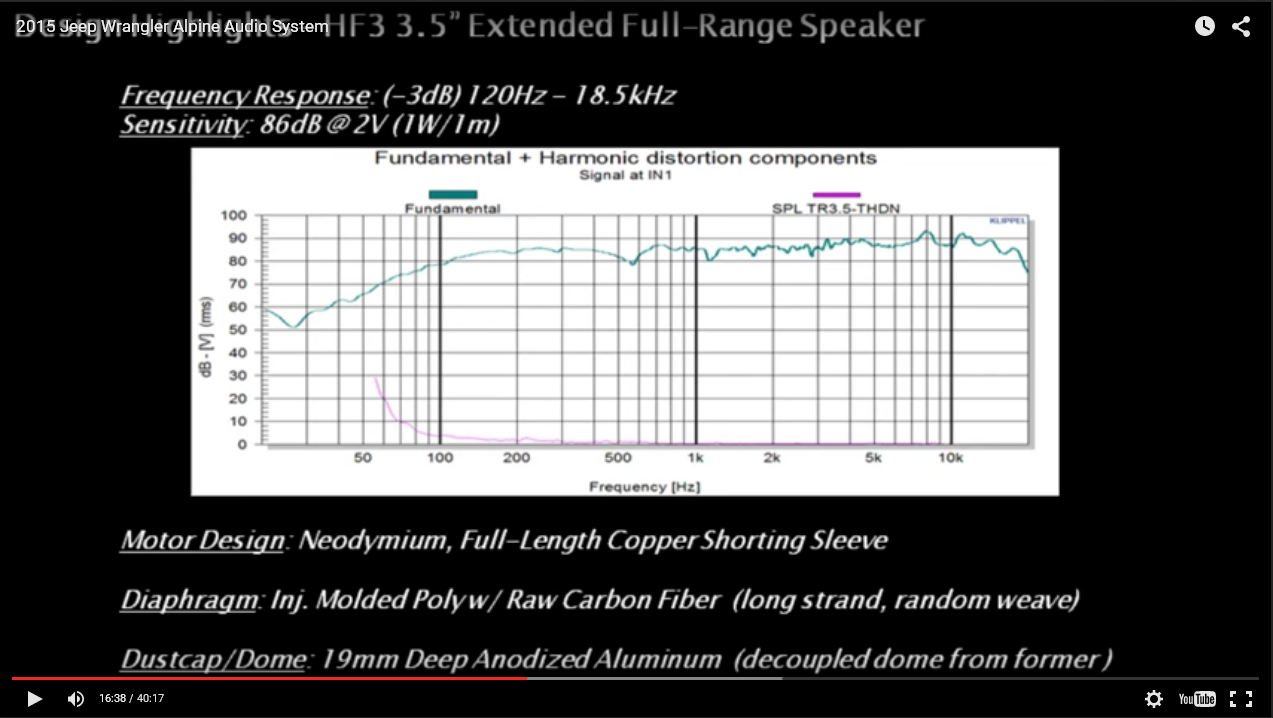
Anyhow, Round 5 may include another driver if I get one before the testing ends. It will be the same setup as Round 4 so you can directly compare with the drivers being discussed in this thread now.
A member asked if TS parameters exist for this driver. I have not seen any published. Here are the TS Parameters for Jeep Alpine as measured with DATS V2 using added mass method on driver with bezel and dust screen removed:
fs=180Hz
SPL=89.07 dB at 2.83v
Re=3.42 ohms
Le=0.0773 mH at 10kHz
Mms=2.865g
Qms=5.203
Qes=1.178
Qts=0.9606
Bl=2.97
Vas=0.45 liters
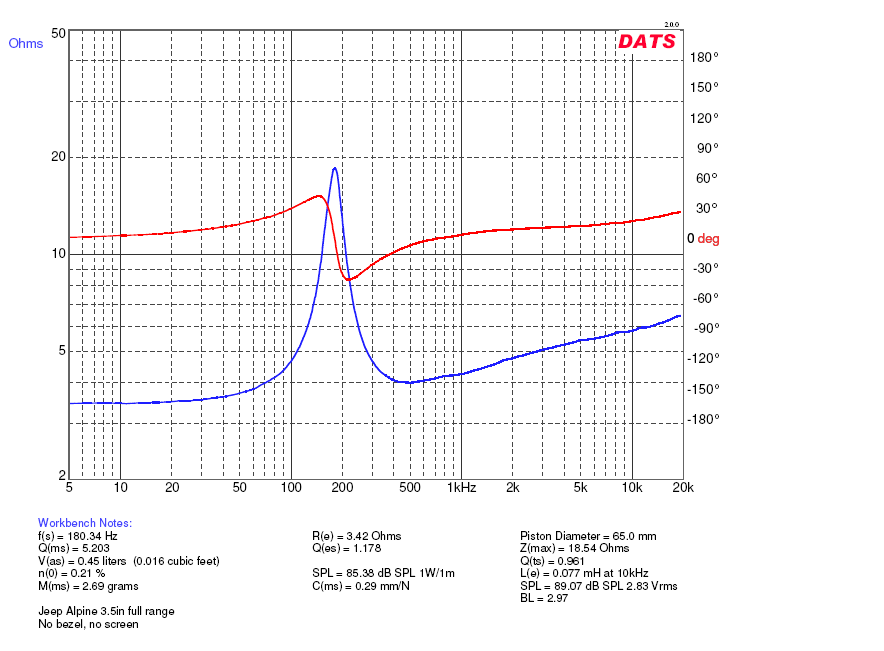
Attachments
Visaton B80 = Omnes Audio 3.5 ?
Decide for yourself:
https://www.oaudio.de/out/media/Datasheet_BB3_5.pdf
Test - technische Daten Lautsprecherchassis Breitbander - Visaton B 80 - 8 Ohm
http://www.visaton.com/bilder/fotos/gross/b80.jpg
https://www.oaudio.de/out/pictures/master/product/2/oaudiobb35.jpg
https://s1.postimg.org/47l02me8j3/ff80e92e.jpg
https://s1.postimg.org/21llguo2sf/oa3.5.png
It just might be that it is not that expensive to get to this level of performance. OmnesAudio from Germany is known for these kind of stunts. Here are Dayton RS225:
https://www.oaudio.de/en/Loudspeake...nesAudio/Woofer/Omnes-Audio-W8-Alu-Black.html
https://www.oaudio.de/en/Loudspeake...esAudio/Woofer/Omnes-Audio-W8-Alu-silver.html
Decide for yourself:
https://www.oaudio.de/out/media/Datasheet_BB3_5.pdf
Test - technische Daten Lautsprecherchassis Breitbander - Visaton B 80 - 8 Ohm
http://www.visaton.com/bilder/fotos/gross/b80.jpg
https://www.oaudio.de/out/pictures/master/product/2/oaudiobb35.jpg
An externally hosted image should be here but it was not working when we last tested it.
https://s1.postimg.org/47l02me8j3/ff80e92e.jpg
An externally hosted image should be here but it was not working when we last tested it.
https://s1.postimg.org/21llguo2sf/oa3.5.png
It just might be that it is not that expensive to get to this level of performance. OmnesAudio from Germany is known for these kind of stunts. Here are Dayton RS225:
https://www.oaudio.de/en/Loudspeake...nesAudio/Woofer/Omnes-Audio-W8-Alu-Black.html
https://www.oaudio.de/en/Loudspeake...esAudio/Woofer/Omnes-Audio-W8-Alu-silver.html
Last edited:
- Home
- Loudspeakers
- Full Range
- A Subjective Blind Comparison of 2in to 4in drivers - Round 4
